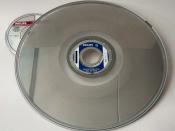Compact disk (CD)
The original creation of the compact disk began with the videodisk in the form of Video Long Play (VLP) read only systems. Despite the introduction of a few writes _ once optical disks of different formats and sizes. The videodisk was not commercially successful.
Phillips and Sony jointly introduced the CD_DA (compact disk digital audio) to the market in 1982.These systems became a colossal success, probably due to its high quality stereo audio signal, which was stored in a digital form.
It was in 1985, that the compact disk digital audio technology was modified, enabling it to be used for computer storage; it was again the cooperation between Philips and Sony, which led to this modification. This computer storage enabled disk, was called a CD_ROM (compact disk read only memory), which later evolved into a standard ECMA_119, specifying the physical format of the CD_ROM.
In 1986 the CD_I (compact disk interactive) was introduced, again by Philips and Sony, the CD_I is a standard for interactive compact disk systems used in interactive training systems which involve music, video, animation, and speech.
The CD_I also responds quickly to commands from the user.
In 1988 the CD_ROM / XA (/ extended architecture) was introduced. Philips, Sony and Microsoft indicated digital optical formats for several media and published the specification.
In 1990 the CD_WORM (write once read many times) technology was initiated as well as CD_MO (magneto _ optical). Worm is a particular technology, which enables a disk sector to be written over only once. Worm is accredited for transaction logging due to the fact that the sequence of data entry can be audited. A Worm disk can also be referred to as a CD_R disk.
A set of standards jointly developed by Sony and Phillips...


